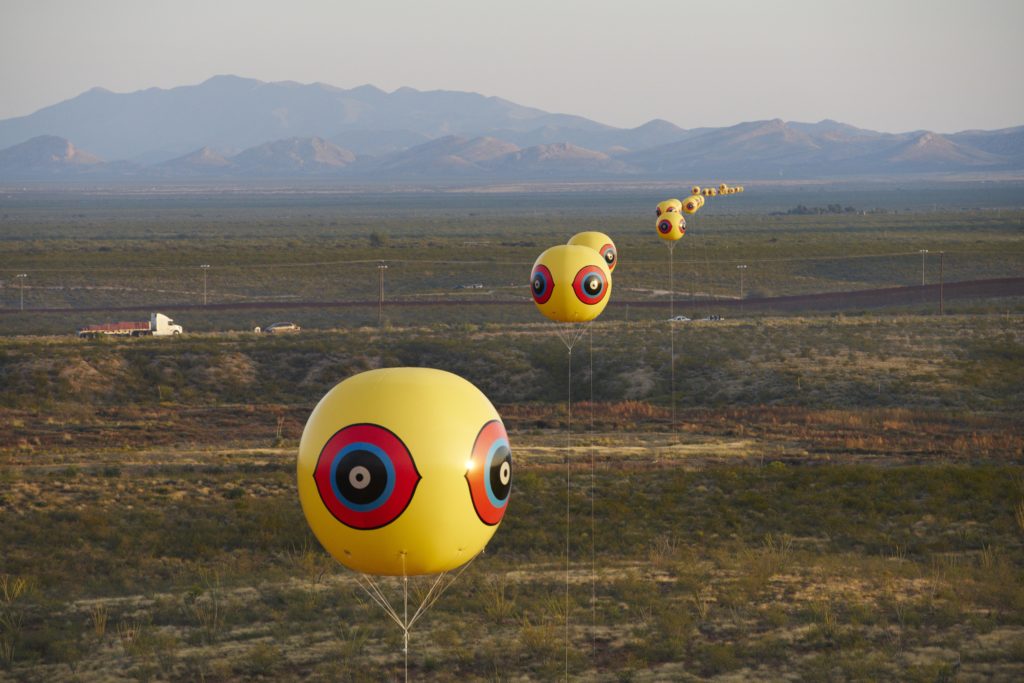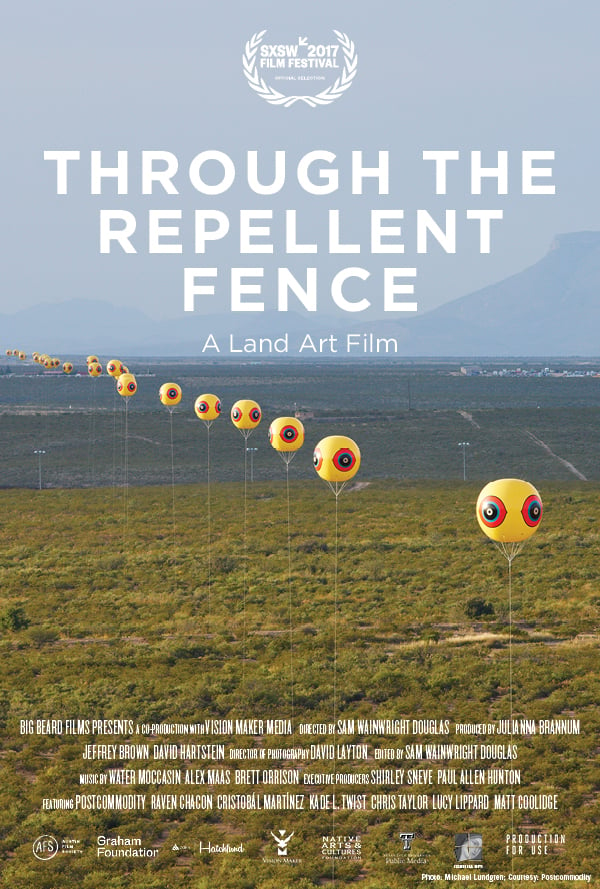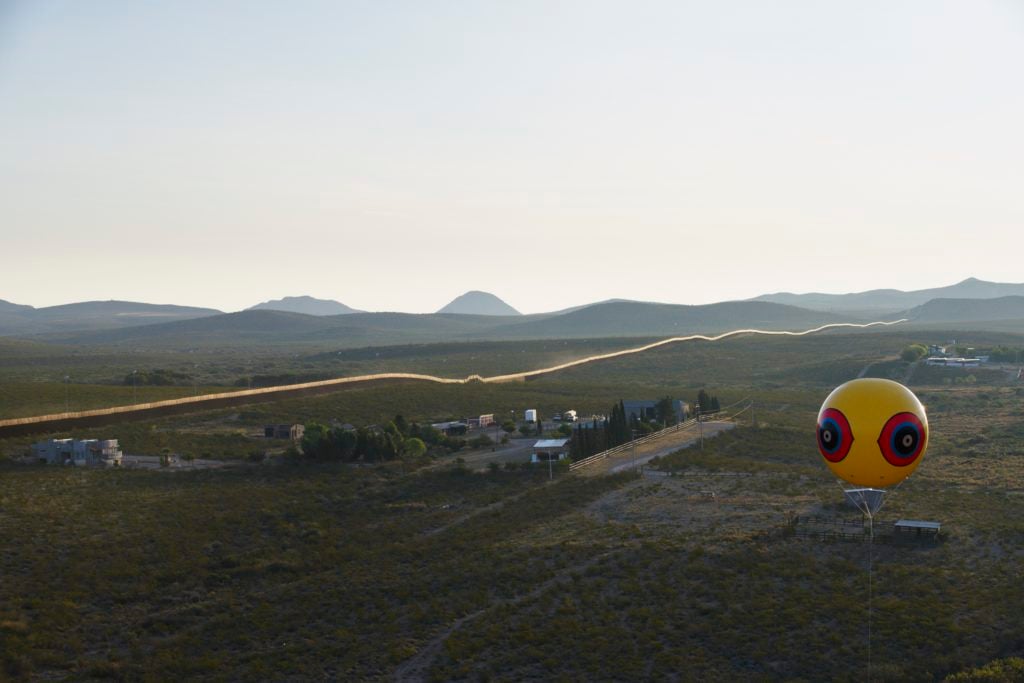On View
Postcommodity Reimagines the US-Mexico Borderlands in ‘Through the Repellent Fence’
A new documentary finds land art in a contentious debate.

A new documentary finds land art in a contentious debate.

Brittany Stigler

In Sam Wainwright Douglas’s new documentary, Through the Repellent Fence: A Land Art Film, the theoretical divide between wall and border proves to be more than the stuff of geopolitical debate, becoming, instead, a potential site of transnational healing and self-determination.
Premiering at MoMA’s Doc Fortnight 2017 series less than a month after President Trump issued an executive order calling for the immediate expansion of the U.S.-Mexico wall, Through the Repellent Fence documents the installation of Postcommodity’s massive land art project, Repellent Fence (2015). A binational, ephemeral fence built across the U.S.-Mexico border., Repellent Fence featured 26 enlarged replica “scare eye” bird chaser balloons staked equidistantly over a two-mile-stretch of land, stitching together the sister cities of Douglas, Arizona and Agua Prieta, Mexico. To stress the temporality of constructed barriers, the piece was designed to last only four days. Douglas’s documentary acts as a record of this event and its communal significance within the border towns it joined.

Photo: Michael Lundgren; Courtesy: Postcommodity.
Running counter to the current national discourse of the borderlands, Douglas’s film works, as he stated, to “dispel the myths of the border,” which often depict an area cannibalized by violence and crime. Tonally, the film achieves this by merging art study and observational filmmaking, juxtaposing the oppressive elements of the border with visions of land art. A lengthy stretch of x-shaped Normandy fencing, for example, appears alongside untitled images of Spiral Jetty, Double Negative, and The Sun Tunnels at the top of the film, elevating the fence itself to a plan of artistic potential. As for violence, it comes by way of wind and brush, making the central physical threat of the film the actual terrain of the borderlands, as opposed to gangs or guns.
While the film comes at a time when the borderlands face a renewed threat of increased political and geographical tumult, Postcommodity’s Raven Chacon, Cristóbal Martínez, and Kade L. Twist conceived Repellent Fence as a response to a long history of divisionary practices that have disrupted cultures and communities along the border. For the past decade, the U.S. has strengthened its military presence in the area, installing surveillance in the form of law enforcement, motion sensors, radar systems, watch towers, and drones, in addition to hundreds of miles of fencing built in accordance with the Illegal Immigration Reform and Immigrant Responsibility Act of 1996 (IIRIRA), which mandated the U.S. to install 700 miles of fencing along the border.

Photo: Michael Lundgren. Courtesy of Postcommodity.
At the same time, President Obama’s tenure led to a record number of deportations, though immigration reform did make considerable progress under the administration’s 2012 directive, the Deferred Action on Childhood Arrivals (DACA), a program that Trump has pledged to rescind.
“In a lot of ways, the political landscape for us in the borderlands has never changed,” said Martínez, noting that their work addresses policies that have been placing physical and figurative borders between communities for years. “It’s really important to disaggregate the public rhetoric from what the government is actually doing. Because [Obama] was able to leverage a message of hope…Meanwhile, he broke up hundreds of thousands of families.”
On the subject of Trump, Martínez agreed with Twist, who suggested that Trump’s administration would not be able to match the amount of deportations that Obama’s saw. Trump “may not be as successful as Obama was, because he’s just pissing everybody off, whereas Obama was just tricking everybody.”
By building a fence that runs perpendicular to the U.S.-Mexico border, Repellent Fence introduces a geographical counter-narrative that speaks to these federal policies in aesthetic terms. What the film shows, however, is how the actual installation of the fence—in addition to all of the pre-installation legal negotiations between the communities of Douglas and Agua Prieta—brought about a re-imagined borderlands at the local level.
“Our initial intention was more of a disruption, when we first started working on this project, [but] the more that we got involved in being at the site, being with these two towns, and working with these two towns,” explained Chacon, “it started to become more about the relationships that we were able to bridge through the project.”
In turn, the project, as is demonstrated in the film by the interactions between the local volunteers and Postcommodity, encouraged community participation that informally amended federal policies aimed at separating the two regions. Or, as Twist explained, the community members were “working to enforce their own self-determination,” which served to advance “a memorandum of understanding that the two communities had.”

Photo: Michael Lundgren. Courtesy of Postcommodity.
This notion of self-determination, coupled with indigenous politics, is central to Postcommodity’s work. While often excluded from the dialogue surrounding the borderlands, recognizing the connection between indigenous narratives and the border communities is crucial to understanding and expanding the scope of the border discussion, a conversation that Postcommodity will continue in their installation at the upcoming Whitney Biennial.
To this end, Repellent Fence, Twist stated, was “also an effort to culturally repatriate indigeneity of the region, of the borderlands and to shift the discourse away from a dehumanizing focus of citizenship” by acknowledging the local communities as indigenous people “because that places them in a larger historical and cultural framework of the Americas.”
“The federal state policies and rhetoric, they have some impact, in the sense that it draws a certain visibility to the issues, but when it comes to our practice…we’re not interested in engaging with federal or state governments with this. We’re interested in thinking of this as indigenous people,” said Martínez. “You can put a Trump in office, or you can put an Obama in office, or you can put a George Bush in office, but at the end of the day, we’d like to be able to do what we need to do locally in the borderlands.”